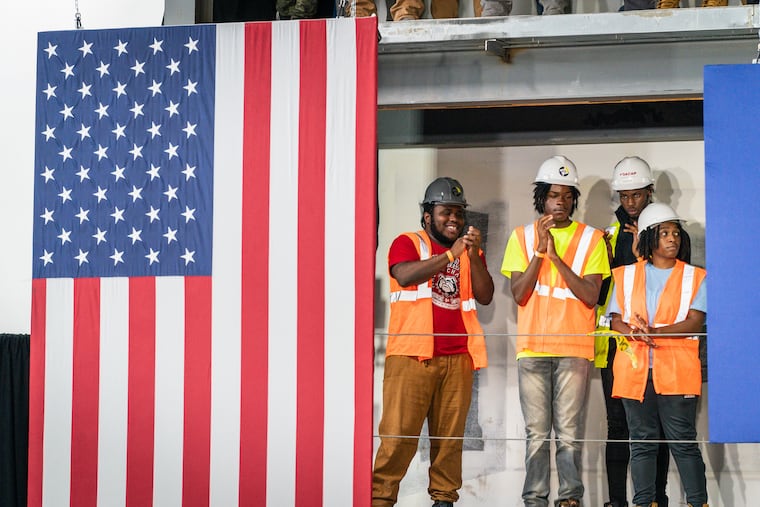Diversifying the building trades would be a win for Philadelphia | Editorial
Likely mayor Cherelle Parker and union chief Ryan Boyer must work together to open up good-paying jobs long denied to people of color.

When Labor Day 1963 was celebrated, most of organized labor in America was on the right side of history as a firm ally in the civil rights movement. A few days earlier, unions had been an important part of the broad coalition that made possible the March on Washington for Jobs and Freedom, organized by the Rev. Dr. Martin Luther King Jr.
The United Automobile Workers provided funding, while the Brotherhood of Sleeping Car Porters, led by the iconic A. Philip Randolph, helped with transportation for the hundreds of thousands who attended the march. At the time, Randolph had been seeking support for such a march for decades.
Yet, on Labor Day 2023, Philadelphia’s dominant building trades unions representing the city’s skilled laborers remain disproportionately white and male. The most recent data from 2012 puts the union workforce at 99% male and 76% white. The situation may have improved since then, but it’s impossible to know since the local building trades have refused to share demographic information.
Sixty years after King’s “I Have a Dream” speech, in a city that is more than 40% Black and where other major unions are predominantly African American, this is a disgrace — one that not only limits opportunity for a group of people but the whole of Philadelphia.
» READ MORE: When it comes to development issues, Cherelle Parker must think broadly about Philly’s growth | Editorial
This racial hoarding of jobs goes beyond what work crews look like in the city. Union construction jobs are one of the few remaining well-paying jobs available to people without a college degree. Closing off this traditional pathway to the middle class has kept many families of color from achieving the kind of financial stability that strengthens communities. A litany of systemic issues in Philadelphia, from generational poverty to gun violence, are compounded by decades of lost opportunities.
If there is cause for optimism, it’s that there may not be a better moment for change.
Philadelphia’s likely next mayor, Cherelle Parker, describes herself as an unapologetic pro-labor Democrat. Parker, who would be the first Black woman to lead City Hall, is a strong ally of Ryan Boyer, the first Black man to head the Philadelphia Building and Construction Trades Council. Together, they represent a distinctive opportunity to establish generational change in the city’s unions.
Of course, even with the ostensible commitment of these two leaders, the task will not be easy. The skilled trades have long resisted efforts to diversify their ranks. In fact, the federal government’s affirmative action “Philadelphia Plan,” which launched in 1967, fell apart a few years later after tradesmen rioted rather than comply.
The city’s decades of stagnation have also played a role. If there are only a few jobs available for painters, pipe fitters, and electricians, it is likely those jobs will go to the sons and nephews of the current painters, pipe fitters, and electricians. It is much simpler to end nepotistic and discriminatory practices when an industry is growing, rather than declining.
That would require an attitude shift by City Council, led by the mayor, on how the city does business to attract large-scale development. The need for major projects is no doubt part of Boyer’s advocacy for the proposed Sixers Center City arena. The $1.55 billion proposal is expected to employ about 9,000 construction workers. That’s roughly a quarter of the region’s unionized construction workforce.
Another big project that could help speed the integration process is the Roosevelt Boulevard subway extension. While updated budget estimates for that project have not been completed, it is likely to cost significantly more than the Sixers arena proposal. It would also present a significant opportunity to grow apprenticeship programs, which tend to be more diverse than the current union membership.
Still, simply having enough work isn’t enough. Philadelphians have heard labor leaders promise to open the rolls if the public supports major projects before, only for the numbers to remain roughly the same. Here, accountability and transparency are key.
» READ MORE: Philly’s onerous tax system is a job killer. Here’s what the mayoral candidates say they’ll do about it. | Editorial
The easiest way to do that would be for the mayor to appoint an official responsible for monitoring the trades, and to regularly publish updated demographic information on union membership and apprenticeship classes, a step Boyer and other labor leaders have often shied away from.
In a meeting with this board, Boyer mentioned that new classes of apprentices are already making gains in terms of representation, but the public deserves to see proof and progress — especially if public resources are invested in construction projects with the aim of breaking down barriers.
The Philly trades should also consider following the example of New York City, which has seen significant progress in trades integration. Formed in collaboration with the city’s largest advocacy organization for contractors, the Edward J. Malloy Initiative for Construction Skills trains and places high school graduates into union apprenticeship programs. Nearly two-thirds of these apprentices are people of color.
Diversifying Philadelphia’s building trades should have been done generations ago. But with the first Black trades leader at the helm and a sympathetic mayor, the opportunity is now. It can’t take 60 more Labor Days for the face of the building trades to reflect the face of Philadelphia.